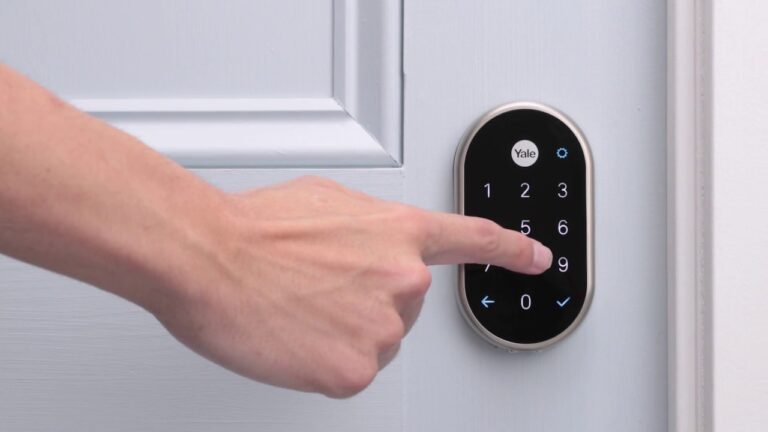Introduction
How To Unfreeze Door Lock On House: Dealing with a frozen door lock on your house can be a frustrating and inconvenient experience, especially during cold winter months. Whether it’s due to icy conditions, moisture buildup, or simply the passage of time, a frozen door lock can pose a significant challenge to gaining access to your home. However, fear not, as there are effective methods and practical techniques that can help you unfreeze a stubborn door lock and restore your access without causing damage.
Confronting a frozen door lock on your house can turn a routine task into a surprisingly daunting one, particularly when chilly temperatures grip the surroundings. The causes behind a frozen lock can be diverse – from freezing rain and snow accumulation to moisture infiltration and subzero temperatures. Such scenarios can render your lock immobile, potentially leaving you locked out or struggling to secure your home.
By understanding the science behind lock freezing and arming yourself with the right tools and techniques, you’ll be prepared to navigate this inconvenience with confidence. We’ll not only address the immediate need to regain access to your house but also empower you with preventive measures to thwart future lock freezing episodes.

Why is my house door lock freezing up?
If your door lock continues to freeze, you’ll likely need to clean your lock, as there is too much dirt within the mechanism that’s retaining moisture. Using a damp cotton swab, insert it into the keyhole and gently wipe around to clean and attract some of the built-up dirt and grime.
One of the primary culprits behind a frozen door lock is the fluctuation in temperature. When temperatures drop, any residual moisture or condensation within the lock mechanism can freeze, causing the keyway and internal components to become immobile. The freeze-thaw cycle exacerbates this issue, as the moisture expands upon freezing and contracts when thawing, potentially trapping the lock in an icy embrace.
Moisture is a common adversary of door locks. Rain, snow, sleet, or even excessive humidity can find their way into the lock mechanism. As temperatures plummet, the trapped moisture can freeze, effectively binding the lock’s moving parts. This freeze-up is especially likely if the lock lacks proper sealing or if there are gaps around the doorframe, allowing moisture to seep in.
Lock mechanisms, like any mechanical parts, require proper lubrication to function smoothly. In cold weather, traditional lubricants may thicken or congeal, impeding the lock’s operation. This diminished lubrication can make it easier for moisture to accumulate and freeze within the lock, exacerbating the freezing issue.
Wind can accelerate the cooling process, leading to a more rapid drop in temperature. If your door lock is exposed to strong winds or drafts, the wind chill factor can cause moisture to freeze more quickly within the lock mechanism, resulting in a frozen lock.
Will hot water unfreeze a lock?
Don’t Use Hot Water
Common knowledge may tell you to warm your lock up, so many think hot water will do the trick. It won’t. While hot water may successfully defrost the lock and allow it to open, it’s only a good trick in the short term.
Risk of Damaging Lock Components: While hot water can melt ice, it can also cause other issues. If the water is too hot, it might expand the metal components of the lock too rapidly, leading to warping or damage.
Rapid Cooling: The lock and its components can cool rapidly in cold temperatures, potentially causing the melted ice to refreeze, exacerbating the problem.
Moisture Intrusion: Introducing water to a lock can exacerbate the freezing issue if the water itself freezes or if it contributes to moisture accumulation within the lock, leading to future freeze-ups.
Potential for Rust: Water can accelerate rusting in metal lock components, particularly if the lock is not dried thoroughly after the hot water treatment.
Risk Mitigation: If you decide to use hot water to unfreeze a lock, it’s essential to take precautions to minimize potential risks:
Use Warm Water: Opt for warm water instead of boiling water. Boiling water can be too hot and increase the risk of damaging the lock.
Avoid Overuse: Use a limited amount of water to prevent excessive moisture from infiltrating the lock mechanism.
Dry Thoroughly: After using hot water, dry the lock thoroughly to prevent moisture accumulation and rust formation.
Use Lubrication: Once the lock is thawed, consider using a lock de-icer or a graphite-based lubricant to prevent future freezing.
Can water damage a door lock?
The salt in the air and especially from the rain slowly but surely eats the metal handle and keyhole of your door, but the problem does not stop there. It goes deeper than what you can see since water droplets can get into the keyhole and start corroding the inner workings of the lock.
Water serves as a catalyst for rust and corrosion, especially when it comes into contact with metal surfaces. Rust can form on the internal components of a lock, leading to friction, stiffness, and reduced functionality. Over time, severe rusting can even cause certain parts to become irreparably damaged, rendering the lock inoperable.
In colder climates, water that enters a lock can freeze during temperature drops. When water freezes, it expands, which can exert pressure on the lock’s components. This expansion can cause cracks, warping, or misalignment within the lock, leading to operational issues and potential damage.
Modern door locks often incorporate electronic components, such as keypads or smart locks. Water infiltration can lead to short circuits, electrical malfunctions, or even complete failure of these components. This not only compromises the lock’s security but also poses a safety risk.
Excess moisture can mix with dust, dirt, or debris inside the lock, forming a paste-like substance that hampers smooth movement. This can result in a jammed lock, making it difficult or impossible to insert or turn the key.
Which oil is best for lock?
Teflon-based dry lubricant is preferred by some locksmiths over other options, like graphite or WD-40. It’s ideal because, besides lubricating your lock, it repels water and dust. That means that once you fix a lock with this type of lubricant, you can expect the lock to be in good shape for a long time.
Non-Stick and Non-Drying: The ideal lock oil should be non-stick, non-drying, and able to remain effective over extended periods. This ensures that your locks continue to operate smoothly without becoming gummy or attracting dirt.
Low Viscosity: Lock mechanisms consist of small, intricate parts that require a lubricant with low viscosity. Thin oils can penetrate tight spaces and provide even coverage, ensuring all moving components are properly lubricated.
Resistant to Temperature Extremes: Locks are exposed to various temperature conditions, so the chosen oil should be able to withstand both hot and cold environments without becoming too thin or thick.
Corrosion Prevention: The oil should offer protection against rust and corrosion. Locks, especially outdoor ones, are susceptible to moisture exposure, making corrosion prevention crucial for long-term functionality.
No Residue: The lubricant should leave minimal to no residue. Oils that leave residue can attract dust and dirt, leading to potential jamming or decreased lock performance.
What is the best oil for door locks?
Teflon-based Lubricants
Top of our list is PTFE lubricants. Polytetrafluoroethylene, or PTFE, is a Teflon-based lubricant that dries inside the lock to leave behind a non-stick, water-repellent film on all the surfaces. Since it’s dry, it doesn’t attract dust or dirt.
Long-Lasting Lubrication: The chosen oil should provide long-lasting lubrication that remains effective over time. This prevents the lock from becoming sticky, attracting dirt, or requiring frequent reapplication.
Resistance to Moisture and Corrosion: Door locks are exposed to the elements, making them susceptible to moisture and corrosion. An effective lock oil should create a protective barrier that resists these damaging factors.
Consistency and Viscosity: Opt for an oil with the right consistency and viscosity. Thinner oils can penetrate small crevices and moving parts, ensuring even coverage and smooth operation.
Low Residue: The oil should leave minimal residue after application to prevent dirt buildup and potential lock jamming.
Graphite Lubricant: Graphite-based lubricants are renowned for their dry, friction-reducing properties. They penetrate deep into the lock mechanism, providing excellent lubrication while resisting moisture and corrosion. Graphite also minimizes the risk of residue buildup.
Silicone Spray: Silicone-based sprays offer a clean, non-stick lubrication that is effective in preventing rust and repelling moisture. They are suitable for a wide range of temperatures and tend to leave less residue compared to other lubricants.
Does weather affect door locks?
Surprisingly, one of the most common causes of lock issues is the changing weather. As temperatures fluctuate, residential and commercial door locks may jam and not work properly.
Temperature Fluctuations: One of the most prominent ways weather affects door locks is through temperature fluctuations. Lock mechanisms consist of various metal components that expand and contract with changes in temperature. Rapid temperature shifts, such as those occurring between day and night, can lead to stress on the lock’s internal parts. This stress can result in misalignment, decreased effectiveness, and, in extreme cases, lock freezing.
Moisture and Humidity: Rain, snow, fog, and humidity are common weather elements that impact door locks. Moisture can seep into lock mechanisms, leading to rust, corrosion, and increased friction. Over time, these factors can cause locks to become stiff or difficult to operate.
Freezing Conditions: In colder climates, sub-zero temperatures can lead to frozen locks. Moisture within the lock can freeze, rendering the lock inoperable. Frozen locks are not only frustrating but can also pose security risks if you’re unable to lock or unlock your doors.
UV Exposure: Extended exposure to sunlight and UV rays can cause materials like plastic and rubber to degrade over time. This deterioration can affect the durability of components within electronic locks, keypads, and other locking mechanisms.
Can I put cooking oil on my door lock?
Don’t use oil.
The oil will just combine with any grime already in the mechanism and compound the situation.
Temporary Solution: Cooking oil is not designed for lock lubrication and may provide only short-term relief. Its consistency may not offer the lasting protection needed for optimal lock performance.
Residue Buildup: Over time, cooking oil can attract dust, dirt, and debris, leading to residue buildup. This buildup can actually exacerbate the lock’s sticking or squeaking issues.
Potential for Gummy Locks: Cooking oil can become sticky or gummy over time, which may cause more problems than it solves. Sticky oil can attract more dirt and create further friction within the lock mechanism.
Corrosion Risk: Cooking oils are not formulated to prevent rust and corrosion, which are common concerns for locks exposed to the elements.
Graphite Lubricant: Graphite-based lubricants are specifically designed for lock mechanisms. They provide dry lubrication that prevents rust and reduces friction without attracting debris.
Silicone Spray: Silicone-based lubricants offer a clean and non-stick lubrication solution. They resist moisture and provide a protective barrier against rust.
Teflon Lubricant: Teflon-based lubricants create a dry, low-friction coating that prevents wear and tear while resisting moisture.
How long do door locks last?
Seven years
Most locksmiths advise that a door lock should be changed once every seven years. However, this depends on a number of factors. If a lock is used rarely, it may remain fully functional for longer.
Quality of the Lock: High-quality locks tend to have more durable materials, better construction, and superior engineering. Such locks are designed to withstand heavy usage and resist the effects of wear and corrosion, potentially lasting longer.
Usage Frequency: The frequency with which a lock is used directly impacts its lifespan. A lock on a frequently used front door will experience more wear compared to one on an infrequently used interior door.
Environmental Conditions: Excessive moisture, extreme temperatures, and exposure to elements can accelerate the deterioration of a lock. Locks exposed to the outdoors or harsh weather conditions may wear out faster.
Maintenance: Regular maintenance, such as cleaning and lubrication, can significantly extend the lifespan of a door lock. Neglecting maintenance may lead to premature wear and decreased performance.
Installation Quality: Proper installation by a skilled locksmith ensures that a lock operates smoothly and without unnecessary stress. Poor installation can lead to misalignment and reduced lifespan.

Conclusion
Armed with the insights and techniques provided in this guide, you’re now equipped to tackle this issue head-on, ensuring that a frozen lock doesn’t compromise your access or security. Whether you opt for simple, DIY solutions or invest in specialized products, you have a range of strategies at your disposal to effectively thaw out your lock.
By implementing preventive measures, such as applying frozen door lubricants, sealing gaps, and shielding your lock from moisture, you can significantly reduce the likelihood of future freeze-ups. Regular maintenance and vigilance can go a long way in safeguarding your home against the grip of winter’s chill.
Your ability to adapt, problem-solve, and overcome obstacles showcases your resourcefulness as a homeowner. By staying informed and proactive, you’re well-prepared to ensure that a frozen door lock remains nothing more than a temporary inconvenience in the grand scheme of homeownership.

